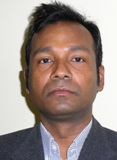Day :
- Track 1: Awareness and knowledge on HIV/AIDS, STDs and STIs
Track 2: Viral, Bacterial, Fungal & Protozoan STDs
Track 3: Understanding and identifying HIV: HIV Related Infections, Co-Infections and Cancers
Track 4: Primary HIV Infection Transmission and Eradication Issues
Location: Grand Ball Room A
Chair
Michael M Ling
GeneBio Systems, Inc., Canada
Session Introduction
Michael M. Ling
GeneBio Systems, Inc., canada
Title: Rapid Molecular Diagnostics of HIV-1 RNA from Plasma
Time : 13:30-13:55
Biography:
Michael Ling, PhD graduated from the University of Guelph and has 25 years of molecular biology, assay, method development experience, and has developed and launched several FDA approved assays. He has written more than 30 papers, holds several US, European and Canadian patents, developed an isothermal amplification technology called DNA Amplification via Scissors-Like structures (DASL,) and is the founder of GeneBio Systems Inc
Abstract:
Rapid HIV diagnostics and viral load testing are critical factors in the overall management of HIV epidemics in developing countries. Over the last two years we have focused our efforts on developing a 30-60 min HIV-1 RNA detection assay for plasma samples. Our assay offers portability, a low cost profile, and high performance results that fill an unmet need in developing countries for rapid molecular detection of HIV (from early to late stage infection). We have developed an early prototype version of a HIV-1 RNA assay that utilizing an optimized two-step process with reverse transcription and isothermal amplification. Using a simple heater and a visual detection method, our HIV-1 assay demonstrates utility and potential as a low cost assay without the requirement of extensive training and skilled technicians. Several reverse transcriptases have been compared (including RTx, AMV RT, MMLV RT and Sensiscript, and Superscript III), and we have used our isothermal amplification technology (DNA Amplification via Scissors-Like structures - DASL) to amplify the resulting cDNA; reaction conditions including the choice of targets, primer design, polymerase enzymes have been optimized to maximize detection. We have successfully amplified RNA purified from HIV positive plasma samples with the limit of detection being less than 100 copies/reaction, as well as amplified directly from HIV RNA plasma samples with no amplification in control samples. We will present the assay procedure and complete results on 30 samples, our challenges and recommendations for further development of this assay into a validated rapid molecular diagnostic HIV assay.
Debbie Y Mohammed
Saint Michael’s Medical Center, USA
Title: High prevalence of trichomonasvaginalis in an urban HIV clinic in Newark, New Jersey, USA
Time : 13:55-14:20

Biography:
Debbie Y Mohammed is an adult nurse practitioner with 15 years experience specializing in the care of HIV infected persons. She completed her doctorate in Public Health with a concentration in Epidiemiology, graduating from Rutgers State University in 2015
Abstract:
Infection with a sexually transmitted infection (STI) among HIV positives facilitates the transmission of the virus to negative persons. Current recommendations in this population include routine screening for gonorrhea and chlamydia in both males and females but trichomonas screening in females only. The objective of this study is to compare the prevalence of STI, by gender, in 2014, in an urban HIV clinic. A retrospective chart review was conducted to determine screening results for chlamydia, gonorrhea and trichomonas in an urban HIV clinic from 4/1/2013-3/30/2015. Women were screened using the APTIMA® Unisex Swab Specimen Collection Kit for Endocervical Specimens and men by urine NAAT testing with APTIMA®. We compared the baseline demographics of patients who received screening using chisquare test of association. We compared the prevalence of gonorrhea, chlamydia and trichomonas, stratified by gender. Data analyses were done using SAS 9.4. Of 1184 patients with a medical visit in the study period, 765 (65%) were tested for at least one STI. A higher percentage of males were tested (64%), p= 0.01, than females. Those who tested were similar to those who did not test by age, race/ethnicity and insurance type. Overall, there were 45 (6%) positive test results, of which 35 (78%) were in females. Trichomonas was the most prevalent STI in males and females, 4 (0.8%) and 31 (11.4%) respectively. The majority of positive trichomonas results were in those aged 35-49 (45%) or >= 50 years (45%). Screening and treating for positive trichomonasvaginalis, in addition to gonorrhea and chlamydia, in this clinic is important for both males and females to prevent the transmission of HIV virus tonegative persons. Trichomonasvaginalis was more prevalent in older patients and as more than 50% of this population is > = 50 years old, this STI may be an important mediating factor in the transmission of infection for this population. The cellsizes were small for most of the measures and results may become more robust with increased screening. Results may not be generalizable to other HIV clinics.
Russom Teshome Welday
Huazhong University of Science and Technology, Tongji Medical College, Wuhan China
Title: Knowledge and Attitude of HIV/AIDS Among women 15-49 years old of Three East African Countries Comparison study
Time : 14:20-14:45

Biography:
Russom Teshome Welday is Assistant Lecturer as well as member of research and postgraduate program in Asmara College of Health sciences, Asmara Eritrea, for the Past 4 years. Currently he is studying Masters Program in Huazhong University of Science and Technology, Tongji Medical College, School of Public Health in Wuhan China. He is one of the trainers for Integrated HIV care and management (IMAI/IMPAC/IMNCI) in Eritrea. He has two papers on process for publication.
Abstract:
Background: women living in sub-Saharan Africa are at great risk of HIV/AIDS. Gender inequalities, inadequate knowledge and negative attitude towards the disease are the major barriers to prevent spread of HIV/AIDS. Thus, the aim of the study was to assess and compare HIV/AIDS related knowledge and attitude of women age 15-49 years old among three East African countries. Methods: Data was taken from Demographic and Health Surveys (DHS) conducted in three East African Countries namely Burundi, Ethiopia and Kenya. Data was analyzed using multivariate logistic regression, taking p-values less than 0.05 as significant. All analyses were done using Predictive Analysis Software (SPSS version 21). Result: Almost all three counties of east Africa were heard about HIV/AIDS before survey. Respondents comprehensive knowledge was 77.2% of in Burundi and 63.6% in Kenya. Only 41.6% of the women from Ethiopia had adequate knowledge. Positive attitude was 67.3% of women from Burundi followed by 54.7% from Kenya and 39.7% from Ethiopia. Upon comparison of knowledge through multivariate analysis, women from Kenya (AOR=1.61, 95%CI=1.50-1.72, p-value=0.000) were more knowledgeable than Ethiopia. Similarly Burundians have 4.89 times more (AOR=4.89, 95%CI=4.57-5.24, p-value=0.000) knowledge than Ethiopian women. Women from Kenya had more positive attitude (AOR=1.29, 95%CI=1.21-1.37, p-value=0.000) towards HIV/AIDS than Ethiopians and, in contrast, women from Burundi had more positive attitude (AOR=2.58, 95%CI=2.38-2.75, p-value=0.000) than Kenyans. Conclusion: As result shows comprehensive knowledge of HIV/AIDS was above average in women from Burundi and Kenya, while for Ethiopian respondents was below average. Similarly for Attitude towards people living with HIV/AIDS respondents from Ethiopia had more negative attitude than women from Burundi and Kenya. Women with no education and living in rural areas have inadequate knowledge and negative attitude towards people living with HIV/AIDS in all three East African Countries.
Sylvia Heloisa Arantes Cruz
Faculdade de Ciências Médicas da Santa Casa de São Paulo, Brazil
Title: Anal intraepithelial neoplasia in HIV-positive patients: a review
Time : 14:45-15:10

Biography:
Sylvia Heloisa Arantes Cruz has completed her PhD at the age of 35 years from Santa Casa de São Paulo - Brazil. She is an assistant professor at Santa Casa de São Paulo – Brazil and at CRT/AIDS São Paulo – Brazil. Her research is on screening anal cancer in HIV-positive patients
Abstract:
HIV-positive patients are described with a high rate of anal dysplasia. One of the main causes for the progress of this disorderly epithelial growth in anal mucosa is the concomitant HIV and HPV infection. HPV acts as a cofactor for the persistent anal dysplasia which will provide a precursor lesion for anal squamous cell carcinoma. The rate of anal cancer has increased nowadays. This dysplasia is described as either high-grade anal intraepithelial (HAIN) or low-grade anal intraepithelial (LAIN). The aim of this study is to compare the findings of the screening in HIV-positive and negative patients and perform a review of the literature. We evaluated 131 HIV-positive and negative patients at CRT/AIDS São Paulo who had previously anal intercourse from January 2013 to December 2014. All of the patients underwent the high-risk HPV DNA test, anal Pap smear protocol and high resolution anoscopy. The anal lesions were treated with 90% trichloroacetic acid (TCA) and 5% imiquimod for 12 weeks. The statistical analysis was performed using chi-squared test and the significance level was set at less than 5%. 57 HIV-positive male patients, 35 HIV-negative male patients and 39 HIV-negative female patients were evaluated. 18 HIV-positive patients had anal lesions and 43 patients were positive for the high-risk HPV DNA test and had anal dysplasia. In conclusion, anal dysplasia was more common in HIV-positive patients. High-risk HPV infection was related to anal dysplasia.
Ibe, Salome N.O
University of Technology Owerri, Nigeria
Title: Effects of Peer-Health-Education on STIs, HIV and AIDS Knowledge and Attitudes of Tertiary Institution Students in Imo State Nigeria
Time : 15:10-15:35

Biography:
Dr. Ibe has a P.hD. in Public Health Education from NnamdiAzikiwe University, Master of Public Health Degree, Bachelor of Science (Nursing) degree from University of Ibadan, Master of Science Degree (Sociology of Development) from Imo State University, Certificate in Population and Health Promotion from Nuffield Institute, University of Leeds United Kingdom in addition to other diplomas and certificates in related areas. She has worked with different healthagencies;World Bank and European Union fundedhealth and development programs/projects. Currently she lectures at the Department of Public Health, Federal University of Technology Owerri and has several publications to her credit.
Abstract:
This study was designed to determine the effects of peer-health-education on STIs, HIV and AIDS knowledge and attitudes of tertiary institution students by comparing the mean gain scores. Quasi-experimental (pre-test-post-test) research design was employed.Two hundred students drawn from the University, Polytechnic and College of Education, using a multi-stage sampling technique participated as subjects in the peer sessions. Data were analysed using ANCOVA and Z-test. Factorial design was used for the interaction effects. Findings revealedimproved knowledge and attitudes on STIs, HIV and AIDS, as depicted by positive mean gain scores. Age group 16-20 years had highest mean gain score (X = 22.31) of STIs, HIV and AIDS knowledge than the rest, while age group 26-30 years had the highest mean gain score (X = 10.59) of STIS, HIV and AIDS attitudes. Males had higher mean gain score (X = 26.05) of STIs, HIV and AIDS knowledge, while females had higher mean gain score (X = 9.77) of STIs, HIV and AIDS attitudes. The first years (100 level students) had highest mean gain score (X = 25.71) of STIs, HIV and AIDS knowledge and also had the highest mean gain score (X = 14.12) of STIs, HIV and AIDS attitudes. Level of study was significant both for knowledge and attitudes (P < 0.01). There was no significant interaction effect of age, gender and level of study. It is recommended that peer-health-education be explored further as a method of communicating STIs, HIV and AIDS to tertiary institution students and youths generally.
Charles I. Tobin-West
University of Port Harcourt Teaching Hospital, Nigeria
Title: Determinants of HIV transmission and sexual risk practices among women of childbearing age in semi-urban communities of Rivers State, Nigeria
Time : 15:50-16:15

Biography:
Dr. Tobin-West is a Public Health Physician and Senior Lecturer in Epidemiology and Primary Health Care at the Department of Preventive and Social Medicine, University of Port Harcourt, Nigeria. He is also a Honourary Consultant Community Physician and Chairman Medical advisory Committee/Director Clinical Services and Training at the University of Port Harcourt Teaching Hospital. He holds anM.D., MPH degrees and a Fellow of the Faculty of Public Health of the National Postgraduate College of Nigeria. He has over 25 publications to his credit.
Abstract:
Sexual risk behaviors are among the key drivers of the HIV epidemic in Nigeria, where heterosexual transmission accounts for 80-95% of all infections.Women are disproportionately affected, with infection rates two to three times higher compared with men, and also accounting for 31% of all new infections.This study was aimed at identifying the determinants of HIV transmission and sexual risk practices among women in order to address their peculiar intervention needs and to minimize the mother-to-child transmission of the virus. Data was generated from 769 women of child bearing age in semi-urban communities of River State, Nigeria in November 2013. Data was analyzed in SPSS version 20 with p<0.05 considered significant. Majority (85.6%) of the women were sexually exposed, with a third,(37.2%) engaged in sexual risk practices which included early sexual debut (< 15 years) (16.7%), multiple sexual relationships (12.9%), use of alcohol (29.6%) and or illicit drugs (5.9%) before sex and occasional or inconsistent condom use (22.4%). Logistic regressionanalysisshowed that women with poor knowledge of HIV were more prone to sexual risks. Also, younger women (15-24 years) were 2.2 times more likely to engage in sexual risk practices than older women (25-49 years), [O.R (95% C.I) = 1.571 (1.106-2.231)], p=0.012,and thesingles2.5 times more at risk than married, [O.R (95% C.I) = 1.714 (1.190-2.469)], p=0.004. There is need to focus on peer education and curriculum-based sexuality education in schools in order to improve knowledge about HIV among women of childbearing age.

Biography:
Dr.Katekaew Seangpraw has completed her M.Sc and Ph.D from Mahidol University (Faculty of Public Health) and College of Public Health Sciences, Chulalongkorn University, Thailand. She is a lecturer at the University of Phayao. She has expertise in health behavior, health education, and health promotion
Abstract:
This quasi-experimental research with 2 Groups and a Pretest-Posttest design was used to evaluate the effectiveness of a life skills model for preventing sexual risk behaviors among university students in Phayao Province. The sample was of a first year in university students. The experimental group was composed of 300 students and 200 students in a comparison group from the same school. The experimental group participated in the integrate life skills model for preventing sexual risk behaviors and participatory learning. The educational activities organized were lecture, brainstorming, group discussion, role-playing, simulation games, naming experience, and 6 life skills training sessions, once a week and 90 minutes for each session. The data were collected from self-questionnaires and analyzed by using the following statistics: frequency, percentage, arithmetic mean, standard deviation, Paired samples t-test, and Independent samples t-test. The results showed that significant improvement in knowledge about STI and HIV/AIDS in the experimental group as compared to the comparison group (p <0.001), changed their self-awareness, self-esteem, decision-making and problem-solving skills (p <0.001). The experimental group also significantly improved communication skills, and behaviors preventive to sexual risk than before the program and measured against the comparison group (p <0.001). A life skills model was found to reduce sexual risk behaviors among university students was effective. Thus, this program should focus on safer sexual behaviors to develop strategies to increase self-efficacy and integration in the university curriculum for sustainability. Changes in sexual risk behavior mat require a longer follow-up.
A Sathiya Susuman
University of Western Cape, South Africa
Title: The impact of early sexual debut and non-use of condom on adolescent sexual behaviour in Malawi
Biography:
Prof. Sathiya’ s field level social science research experience on Demographic analysis and Reproductive health within a span of 12 years of job experience. He did Master of Arts (MA) in Population Studies, Master of Philosophy (M Phil) in Population Studies with specialization in Population Studies, Applied Statistics and Ph D in Demography with specialization in Fertility and Contraception. His area of research is fertility, mortality family planning and reproductive health. He has published several research articles in reputed journals
Abstract:
This study examines the impact of early sexual debut and non-use of condoms on the sexual behaviour of adolescents in Malawi, by identifying the determinants of these two indicators, and examining their impact on adolescent sexual behaviour. Data was obtained from the Malawi Demographic Health Survey 2010. A weighted sample of 9559 females and 2987 males aged 15-24 years was subjected to bivariate and logistic regression techniques. Females were more vulnerable to infections then males. Muslim females were more likely to initiate sexual activity earlier than their male counterparts and females with no education were more likely to initiate sexual activities early. The prevalence of non-use of condom was 1.5 times higher among Muslim females, and 6.2 times higher among those with no education. However, married females in the poorest quintiles were about 1.5 times more likely not to use condom. Encouraging these adolescents to abstain from sexual activities, use condoms consistently and delay sexual initiation will help curb the spread of STIs.
Muhammad Kamran Hanif
University of Lahore, Pakisthan
Title: Knowledge Attitude & Practice regarding AIDS/HIV among Pakistani Womenan analysis of PHDS
Biography:
M. Kamran Hanif has been working as Lecturer at university of Lahore and as a visiting lecturer at university of South Asia.He completed his master’s degree from university of the Punjab and now he is doing his m.phil from same the institution. Previously he was head of examinations in National College of Arts Lahore, Pakistan. He has published more than 5 papers in reputed journals and has been serving as an editorial board member of repute
Abstract:
Knowledge about HIV/AIDS and sexually transmitted diseases (STDs) is the most demanding topic these days. Women are more vulnerable to STDs including HIV/AIDS. The prevalence of HIV and Aids is increasing worldwide also in Pakistan the prevalence of HIV is 5 %.
Objective of the study is to assess the sexual preferences, knowledge attitude and practice of Pakistani women regarding HIV/AIDS.
Data from PDHS 2012-13 was used. It was a cross-sectional study. A sample of 13558 women aged 15 to 49 years was taken.
The mean age of the respondents was 32.69±8.55 years. There were 46.8% respondents from urban area and 53.2% from rural area, 56.4% respondents had never heard about AIDS where as 43.6 % ever heard about AIDS. Among the respondents 54.4% responded that they always use condoms to reduce the risk of getting HIV, 77.3 % responded that they have only one sex partner to reduce the risk of getting HIV,25% think that they can get HIV by mosquito bites, 30% think that they can get HIV by sharing food with persons who have HIV, only 2.4% respondents had STI in last 12 months, 69.2% respondents think that HIV is transmitted during pregnancy, 79.9% respondents don’t know where to go for an HIV test.
In Pakistan there are less number of people aware about HIV/AIDS so there is the need for a campaign through media and all accessible sources to aware the women of all ages about AIDS, HIV.
- Track 5: Global Epidemiology of HIV/AIDS, STDs, & STIs
Track 6: HIV research and therapy
Track 7: Social Strategies for HIV and STDs Prevention
Track 9: Lived experience of HIV
Location: Atlanta
Chair
Yukihito Ishizaka
National Center for Global Health and Medicine, Japan
Co-Chair
Debbie Y Mohammed
Saint Michaels Medical Center, USA
Session Introduction
Nilda Fernandez
CT Children's Medical Center, USA
Title: Engaging Youth in HIV/STD Prevention: Hartford Youth HIV Identification & Linkage (HYHIL) Consortia
Time : 11:15-11:35

Biography:
Nilda Fernandez is a Social Worker, Community Health Specialist and passionate advocate. Specializing in medical case management services with children, youth and women impacted by HIV/AIDS. Interested in academic work, grant writing and translation projects. Keen interest in entrepreneurial initiatives in behavioral health, consulting initiatives and public policy
Abstract:
The Hartford Youth HIV Identification and Linkage Consortia is a clinically and cost effective efficacious HIV/STD prevention approach that promotes, as well as, ameliorate underlying social risk factors that can result in poor outcomes to reaching high risk and vulnerable youth. Community engagement and pooling of resources are essential processes in the implementation of high impact prevention particularly as landscape changes in both the health care and HIV service ecosystems. Existing CDC data estimates that every year 10 million new sexually transmitted infections, including HIV, occur among youth, costing the nation almost $16 billion in health care costs every year. Early detection of HIV/STD is crucial to the overall well-being of youth in the US today. The Hartford Youth HIV Identification & Linkage Consortia (HYHIL) uses an innovative, evidence informed approach to increase early identification of HIV/STD positive youth. HYHIL works to increase prevention education and awareness, and to link youth to health care and employment services. HYHIL was formed in 1999 by UConn Health and the Connecticut Children's Medical Center. As a result of the success of collaborative efforts of many agencies and people, HYHIL has reached over 40,000 youth, in both school and community settings. Those youth have received HIV/STD education and/or screenings, and have produced a 10% positivity rate for STDs during the targeted interventions. Agencies within the community that serve at risk youth work together with community agencies that provide HIV/STD testing and linkage to care. This collaboration can effectively educate youth, while identifying those infected with HIV and providing necessary treatment and interventions. Collaboration along with the pooling of resources is a cost effective and a key component in the successful implementation of the HYHIL model. HYHIL operates as a comprehensive coalition that can effectively ensure that youth have access to and benefit from seamless care coordination. This abstract presents the HYHIL model in hopes that it can work to benefit youth in other communities to increase access to adolescent health care services, improve early identification of HIV/STD positive youth andreduce health care costs. We will explore how the collaborative operates, the structural requirements needed to sustain it andthe social impact of replicating the HYHIL model in other gravely affected areas.
Simon Kang ethe
University of Fort Hare, South Africa
Title: Exploring Myths Associated with HIV/AIDS with Examples from A Few Countries of the World
Time : 11:35-12:00

Biography:
Simon Kang ethe is currently working as a professor at University of Fort Hare, South Africa.
Abstract:
There are various myths and misconceptions surrounding HIV/AIDS within South African communitiesthat lead to the stigmatization and discrimination of people living with HIV/AIDS. The aim of this paper is toexplore and spell out the underpinnings on underpinnings on myths surrounding HIV/AIDS in South Africa. Thispaper has used a review of literature methodology. Findings indicate that South Africa embraces immense mythicalbeliefs about HIV/AIDS. Also myths flourish due to: misinformation, misinterpretation, misperceptions ofinformation associated with HIV/AIDS; are reinforced by cultures and patriarchy; and are also associated with thetraditional healers. As a way of dispelling the myths, the paper recommends clients to look or seek scientificevidence in the therapies at their disposal, adapt the use of condoms, demystify the use of the ARV treatment modalities; and enhance community education; and government to regulate the work of traditional healers.
Ezinna Ezinne Enwereji
Abia State University, Nigeria
Title: Emphasizing Reproductive Health and HIV/AIDS prevention to Youths from the Religious Perspective
Time : 12:25-12:50
Biography:
Enwereji Ezinna Ezinne is a Professor and Lecturer in Dept. of Community Medicine, College of Medicine, Abia State University, Nigeria
Abstract:
Background It is assumed that religion shapes everyday beliefs and activities of individuals including that of youths. The problem is that most times, some religious groups out of ignorance exclude their members from associating themselves with HIV prevention. The need to use religious beliefs to enhance prevention of HIV and other sexually transmitted infections among youths in the Church cannot be overemphasized. Here the roles of religious leaders in discouraging HIV-related issues like stigma, discrimination and others among members including youths will be emphasized. In this study, awareness will be created on how youths could integrate religious beliefs with HIV prevention to ensure compliance to HIV/AIDS interventions
Materials and Method An interactive seminar was held with a sample of 538 youths between 18-51 years who attended the 2010 camp meeting was studied. In effect, all the 538 youth members of Seventh-day Adventist church youth volunteer movement were studied. Researchers used combinations of methods to collect data. Story-telling and pictures of various STIs were used to explain mode of transmission and show how youths could be at risk of HIV infection. Certain strategies to enhance HIV prevention among youths like ‘say no to sex’ and others were highlighted. Thereafter, a 23 self administered questions which centered on knowledge of HIV risk factors, effective methods of preventing HIV infections and others was used for the study. Descriptive statistics including simple percentages on frequency tables were used for analysis.
Results Before the training, a good number of the respondents 404 (75%) had poor knowledge of sexually transmitted infections as a risk factor for HIV infection. HIV and other sexually transmitted infections (STIs) were seen as punishment from God on those who committed adultery and fornication. A total of 377(70%) respondents were of the opinion that people living positively with HIV/AIDS (PLWHA) and other STIs committed ominous sins and should be isolated. About 280(52%) of the participants were of the view that they would not disclose their HIV status if infected.. Although 119(22%) of the respondents believed that prayer could cure HIV, as high as 102(19%) of respondents are of the view that HIV has no cure and that youths should avoid being infected.
Conclusion The fact that youths in the church regarded fellow members who are HIV positive as adulterers and/or fornicators shows poor knowledge of mode of HIV infection. There is therefore, the need to organize regular HIV-education outreach for religious groups to reduce beliefs that discourage HIV prevention.
Ying Gu
Xiamen University, China
Title: Molecular insights into the inhibition of HIV-1 infectionusing a CD4 domain-1-specific monoclonal antibody
Time : 13:50-14:15

Biography:
Dr. YING GU, associate professor of molecular virology, is with School of Life Sciences, Xiamen University, China. She leads a group in State Key Laboratory of Molecular Vaccinology and Molecular Diagnostics, and her interests focus on the epitope identification ofHIV, Hepatitis E Virus,and HumanPapillomavirus. She contributed to the research and development of HIV diagnostics, Hepatitis E vaccine and HPV vaccine.Regarding to HIV research, she endeavors to generate monoclonal antibodies against HIV infection and investigate the assembly of HIV gag protein.She has authored or co-authored a total of 25 papers and 8 patents
Abstract:
The infection with human immunodeficiency virus type 1 (HIV-1) is associated with acquired immunodeficiency syndrome (AIDS).An HIV-1 infection in a host cell occurs through an ordered process that involves HIV-1 attachment to thehost’s cellular CD4 receptor, co-receptor binding to CCR5 or CXCR4, and the subsequent fusion with thecellular membrane. The natural viral entry pathway into a host cell provides an opportunity to developagents for the treatment of HIV-1 infections. Several engineered monoclonal antibodies specifically targetingCD4 have shown antiviral activities in clinical trials. Here, we report on an anti-CD4 mAb (15A7)that displays a unique binding specificity for domain 1 of CD4, whose epitope partially overlaps with thegp120 binding region. Moreover, 15A7 displays a much stronger binding affinity to CD4+ cell lines afterHIV infection. 15A7 is able to block and neutralize a broad range of primary HIV-1 isolates and T cell-linepassage strains. Notably, the bivalent F(ab’)2 form of 15A7 is more effective than the Fab form in blockingHIV-1 infection, which is further supported by molecular docking analyses. Together, these results suggestthat this novel antibody may exert its antiviral activity by blocking gp120 targeting to the CD4 receptoror competing with gp120 for CD4 receptor binding and might present post-attachment neutralizationactivity. This antibody could provide a new candidate to efficiently block HIV-1 infection or provide newstarting materials for HIV treatment, especially when HIV-1-resistant strains against the current CD4mAb treatments have already been identified.

Biography:
David L. Massey is highly regarded in the community as an individual giving a voice to others by sharing the stories of those who are either too embarrassed to speak due to stigma. David is sought after by major HIV/AIDS Prevention groups and organizations such as: Faith in the Bay, San Francisco, CA and the Black Women’s Health Imperative, Washington, D.C. He is able to be humorous and relatable while continuing to promote an optimistic view of what life can and should be for all people infected with and/or affected by HIV/AIDS. David has an infectious energy that has a way of grabbing the audience due to his love for people who are seemingly going against the odds. David is also a relationship correspondent for GimmyKiss.com. Los Angeles, CA.
Abstract:
This is a presentation which tells the story of an African American gay male and how he deals with living with HIV for the last 6 years of his life. The presentation highlights the challenges, struggles, and difficult conversations around stigma, as well as the journey of different business as well as personal relationships. The lines of how mental health and physical health played a vital role in his overcoming the challenges of medication adherance. The new information regarding PrEP and how its impact regarding his sexual behavior. The oral presentation will be the first hand account of working in HIV prevention, through diagnosis, to what life is like for this young man today.
Simon Kang ethe
University of Fort Hare, South Africa
Title: The Panacea and Perfidy Associated with ARVS and HIV/AIDS Disease in Selected Countries of the Developing World
Time : 14:40-15:05
Biography:
Simon Kang ethe is currently working as a professor at University of Fort Hare, South Africa.
Abstract:
The aim of this article is, through a review of literature, to discus and debate the panacea and perfidyassociated with taking ARVs (Arghandab River Valley Antiretroviral Drug) and living with HIV/AIDS with examples from South Africa and Botswana. Findings indicate that ARVs elongate lives; facilitates the fulfilment of both theMillennium Development goal number 6 of combating HIV/AIDS by 2015 and some country specific policies onHIV/AIDS. ARV’s access is also associated with; draining national coffers; deterring commitment to behaviouralchange; serving as an entry point to grants; inadequate education to People Living With HIV/AIDS (PLWHA) inSouth Africa; dependence syndrome; discrimination; side effects; increased sexual libido; campaign funders extendingimperialism; poverty ;promoting feminization of poverty and lowered accountability; and cultural disruptions.
Nirajan Bhusal
Kathmandu University School of Medical Sciences, Nepal
Title: Molecular Epidemiology of HIV-1 in Central Region of Nepal
Time : 15:20-15:45
Biography:
Dr. Nirajan Bhusal has completed MBBS in 2006 from University of Science and Technology, Bangladesh and PhD in 2014 from Mahidol University, Thailand. Since then, he has been working as a Lecturer in Kathmandu University School of Medical Sciences. He has been contributing on routine clinical service of diagnostic microbiology laboratory as an expert virologist. Beside academic activities, Dr. Bhusal has been involved in various research activities too.
Abstract:
Full length HIV-1 genome sequencing provides important data needed to address on research and development on diagnosis, treatment and prevention of HIV-1 infection. About 0.5% (64,000) of Nepal population was estimated to be HIV positive. Cross border trafficking of sex workers is a major problem contributing to increasing HIV rates in both India and Nepal. Here we examined the genetic diversity of HIV-1 isolated from central region of Nepal. 136 Blood samples werecollected from HIV-1 infected individuals attending VCT (voluntary counseling and testing) clinic between May-August 2011 at Bharatpur Hospital in Nepal. Based on complete clinical, epidemiological, and viral load data, 40 individual samples from total 136 representing all risk groups of HIV, were selected for further studied. Nucleotide sequence analysis was done following protocol of near full length genome (NFLG). There was intermixing of subtypes within transmission risk groups. However phylogenetic analysis then allowed assignment of most samples amplified belongs to HIV-1 subtype C (a distinct lineage from India). Around 10% of samples were identified as CRF01_AE and CRF08_BC. The identification of these subtypes and CRFs in the central region of Nepal is important in epidemiological tracking as well as will provide information of new antigenic regions of circulating strains, which may unfold the development of an effective vaccine in future.
Rubina Ghani
Baqai Medical University, Pakistan
Title: STD pathogens determined in semen using PCR and flow-through hybridization technology
Time : 15:45-16:10
Biography:
Rubina Ghani is Professor/ Molecular Biologist at Baqai Medical University/Pathological & Molecular Laboratories, Pakistan
Abstract:
Background: The prevalence of sexually transmitted Disease (STDs) among hotel-based sex workers (HBSWs) in Karachi, Pakistan, was studied. These hotel workers are considered as high risk group because of their age, economic independence, low education and residence in a place away from their family. Aim:The aim of this study was to access in health care facilities for diagnosis and common pathogens of STDs, those causing infertility and Chlamydia trachomatis, Neisseria gonorrhoeae and Mycoplasma hominis. Genital wart is a highly contagious sexually transmitted disease caused by some sub-types of human papillomavirus (HPV). Material and Methods:Semen samples were obtained by masturbation into sterile containers after sexual abstinence of 48 to 72 hours. Samples were subjected to semen analysis within one hour of collection and processed for freezing within two hours of collection. The concentrations of sperm as well as sperm motility were also determined. DNA extraction was extracted of all the samples and the PCR assay was performed. The amplicons are subsequently hybridized to pathogen-specific capturing probes via “Flow-through” hybridization. Result:.During our study we came across with the STI pathogens present in our population and the reason for infertility was the main cause. When Chlamydia trachomatis and Neisseria gonorrhoeaewere detected in their wife’s were also screened and these STI pathogens were identified. Conclusions The main route for the transfer of STI pathogens were the men special those who visited commercial sex workers or hotel-based sex workers as they were working in other cities and the complained for infertility.Screening for bacterial STI pathogens, Mycoplasma hominis, Chlamydia trachomatis and Neisseria gonorrhoeaeare strongly recommended because these pathogens can cause serious reproductive complications such as pelvic inflammatory disease, ectopic pregnancy
- Track 8: AIDS Stigma and Discrimination
Track 10: HIV in Women
Track 11: HIV and Aging
Track 12: HIV and Cardiovascular Diseases
Track 13: HIV and Bone Damage
Location: Grand Ball Room A
Chair
Nwako Francis
Federal Medical Centre Owerri, Nigeria
Session Introduction
Joyceline Ntoh Yuh
University of Oldenburg, Germany
Title: Socio-cultural construction of HIV/AIDS stigma among African-migrant women in lower Saxony, Germany
Time : 09:30-09:55
Biography:
Joyceline Ntoh-Yuh is a Feminist and Ph.D candidate in the University of Oldenburg, Germany. She holds an MA in Women & Gender Studies from the ISS Erasmus University Netherlands. Her research interest includes HIV/AIDS related stigma, gender issues, Sexual and Reproductive health. Since 2006 she took keen interest in the field of HIV/AIDS were she researched on the impact of HIV on Agriculture affecting mostly women with the UN FAO Gender unit, mainstreaming HIV policies in UNFFE Uganda, HIV stigma & child bearing in Cameroon and currently facilitates workshops with MA students in the area of Gender, Migration and HIV/AIDS.
Abstract:
Migration is a process that is linked not only to positive aspects such as remittances, socio-cultural changes initiated by the diaspora communities, but also negative consequences such as integration problems, and the rapid spread of infectious diseases among others. Migration is associated with diseases where migrants are perceived as carriers of vectors. Migrants, tourists and expatriates who cross international boarders move with diseases that are not easy to detect by receiving countries medical personnel. More so, such diseases require culturally appropriate treatment plans considering migrants are transmitters and recipients of HIV infection. Migrants are in most cases moving from countries where such diseases are highly prevalent to countries with low infection rates. The association between HIV and migration relates to factors such as alcohol abuse and occurrence of many STDS among migrants, high risky sexual behaviors away from home, and inconsistent condom use. Migrants have to face the harsh reality of HIV in foreign countries without ruling out stigma. An estimate of 80,000 people are living with HIV in Germany in 2013 with 4,400 sero-positive persons in the State of Niedersachsen which counts amongst the high HIV prevalence states in Germany. It is worth mentioning that the estimates so far are clinically diagnosed cases with several undiagnosed cases while others don’t reveal their HIV status. In so doing, HIV-related stigma stands a major barrier in seeking voluntary counseling and testing especially within the African communities. Gender and culture play a significant part in the aftermath of the infection. Women are more likely to be blamed for the transmission of HIV compared to men. All these complicate the disclosure of infection and prevention of HIV transmission. HIV prevention efforts are slowed down by societal and cultural factors that largely lead to stigmatization of HIV infected and affected individuals. The current research therefore examines the socio-cultural constructions of HIV stigma and dilemmas as African-migrant women struggle to cope with the challenges posed by HIV/AIDS in their day to day lives. The social context of HIV-related stigma is reflected in negative behaviors including discrimination, denial, secrecy and self-blame. Most HIV infections are through heterosexual transmission, a mode of transmission closely linked to sexual promiscuity and the resultant HIV-related stigma. The complexity surrounding HIV-related stigma cannot be ignored considering the fact that, it is layered amongst other stigmas such as gender and promiscuity. Moreover, socio-cultural perspectives that triggers HIV-related stigma arises from the fact that individuals infected with HIV/AIDS are labeled and perceived as different from the rest of society members. Intersectionality is an ideal framework for analyzing complex health inequalities that occurs among HIV-infected subgroups especially African women whose experiences are different from their male counterpacts. Multiple factors often precipitate stigmatization experiences and their social identities at the individual level such as being female, ethnic minority (or race), low economic status interlocks with oppression forces at the macro level of society for instance classism or sexism which creates social injustice (health care inequalities). It is vital to examine and understand the underlying aspects creating and re-enforcing HIV-related stigma in order to design culturally sensitive intervention programs to combat the general fight against HIV/AIDS in a global setting.
Ekambaram Umapathy
Walter Sisulu University, South Africa
Title: An association between vasoactive agents and etiology of hypertension and obesity in HIV patients in Mthatha, South Africa
Time : 09:55-10:20
Biography:
Ekambaram Umapathy is Associate Professor at Dept. of Human Biology, Faculty of Health Sciences, Walter Sisulu University, South Africa
Abstract:
AIM: To determine the physiological effects of HIV infection, blood pressure and body composition on the changes of ET-1 and NO and association between ET-1 and NO. Methods:This was a descriptive and comparative study. A Quota sample method was used. The study population consisted of 154 participants categorized into the following groups: 57 HIV negative participants (A), 40 HIV positive not on treatment participants and 57 HIV positive on treatment participants. Enzyme immunoassay kitand nitrate/nitrite colorimetric assay kitwere used for the determination of ET-1andNO. Anthropometric measurements and hemodynamic body composition were determined. Results:Resting metabolism, waist circumference and hip circumference had low mean levels in both HIV positives groups compared to HIV negative group. Interaction of blood pressure and Body Mass Index across the HIV status groups, SBPshowed no significant difference among the different groups. However, DBP and PP showed significant differences between the study groups (p<0.0001).Mean values of endothelin and nitric oxide were increased in HIV positive not on ART and HIV (+) on ART compared with the HIV negative group. Conclusion:NO, ET-1, ART and HIV itself were associated with the pathogenesis of endothelial dysfunction in persons with HIV infection. Elevated endothelial markers namely ET-1 and NO can lead to improvement of endothelium dependent relaxation to some extent but not completely. Although these markers have deleterious effect on the endothelium but can also serve as up-regulator of hypertension and obesity.
Sahreen Malik Bhanji
Aga Khan University School of Nursing and Midwifery, Pakistan
Title: Social determinants of depression among HIV positive patients in Karachi, Pakistan
Time : 10:20-10:45

Biography:
Sahreen Malik Bhanji has completed her MScN (2014) and BScN(2010) from The Aga Khan University School of Nursing and Midwifery Karachi, Pakistan. She has worked as a Registered Nurse in Medical-Surgical Ward at the Aga Khan University Hospital; from August 2010 till August 2012 in the following capacities: 1. Nurse Intern: Worked as a Nursing Intern in Medical-Surgical Ward at the Aga Khan University Hospital, Karachi; from August 2010 till August 2011. 2. Team Leader: Worked as a team leader (November, 2011 to August, 2012) 3. Special Care Unit (SCU) Nurse: worked as a special care unit nurse (June,2012-August,2012) 4. Clinical Preceptor: Worked as clinical preceptor in Medical-Surgical Ward for year IV BScN student for two months (May2012-June 2012). She has published more than 17 papers in reputed journals and has been serving as an editorial board member of the Journal of Pakistan Medical Association and Journal of Pioneering Medical Sciences.
Abstract:
The advancement in treatment regimens, in the form of various anti-retroviral treatments (ART) for treating HIV/ AIDS, has helped its victims to achieve a longer life expectancy (Biswas, 2007). However, the challenge now for them is to live a better quality and mentally healthy life. Asante (2012) states that once a person is diagnosed with HIV, he is likely to suffer from low self- esteem, social isolation, and poor psychological well-being, eventually leading to inability to cope with the entire situation. The prevalence of depression in HIV/AIDS patients has been reported in different studies to be ranging from 22%–45%, compared to 5% and 15% prevalence in the general population (Biswas, 2007; Buckingham, Schrage, &Cournos, 2013; Kilmarx, 2009; Mello, Segurado, &Malbergier, 2010). This suggests that depression is one of the most prevalent psychiatric diagnoses observed among HIV-positive individuals with greater reported prevalence than the general population. Depression related to certain outcomes and risk behaviors, like poor adherence to medication regimen, feelings of self-neglect, apathy, forgetfulness, and decreased immune function (Asante, 2012). Some evidences suggest that it may also be associated with increased mortality in HIV-infected individuals (Overman& Anderson, 2001). While these studies in the existing literature suggest a high rate of depressive illness and symptoms among people living with HIV, they have not been able to focus on the definite causes of depression among this group.
Nwako Francis
Federal medical centre Owerri, Nigeria
Title: Pulmonary cryptococcosis in a known TB/HIV co-infected client attending care in FMC Owerri: a case report
Time : 11:00-11:25
Biography:
Dr. NWAKO Okechukwu Francis had his B.Sc in Applied Microbiology(upper credit ) in 2001 and proceeded to Medical School where he graduated in 2009. In 2012, he obtained his M.Sc( Medical Microbiology) and has completed his Ph.D course work in Medical Microbiology with major in Mycology. He hope to complete his research work by 2016. He obtained his Primary in Internal Medicine in 2010 and became a specialist in Internal Medicine in 2015 from the West Africa College of Physicians. He has published several original articles in international journals and has attended several conferences both locally and internationally including the famous HIV/AIDS 2013 organized by OMICS conferences. He has reviewed many articles for British Journal of Medicine and Medical Research and Journal of AIDS
Abstract:
Will be updated soon....
Pulin Kumar Gupta
PGIMR, Dr Ram Manohar Lohia Hospital, India
Title: Vitamin D levels in HIV infected patients and its correlation with severity of disease
Time : 11:25-11:50
Biography:
Pulin Kumar Gupta is Associate Professor (Medicine) and in-charge of HIV/ART Centre PGIMR, Dr. Ram Manohar Lohia Hospital, India.
Abstract:
Objectives – To assess the levels of vitamin D in patients with HIV infection and to correlate them with measures of disease severity. Methods – 170 HIV positive patients (on ART & ART naïve) in different stages of disease were recruited from ART Centre PGIMER, Dr RML Hospital. Patients on any drug or illness affecting vitamin D/calcium metabolism were excluded. It was a cross sectional observational study over 68 weeks where patients were divided into 3 group (according to CD4 counts) and 25-OH vitamin D levels (deficiency < 20 ng/ml & insufficiency 21-29 ng/ml) were measured. Result – Out of 170 HIV positive cases [134 males (78.8%)] and 36 females (21.2%)], 93.53 % of patients were vitamin D deficient (i.e. 25-OH vitamin D < 20 ng/ml) & 5.30% had vitamin D in insufficiency (range = 20-30 ng/ml) hereby showing that 99% of these patients had hypovitaminosis-D. The mean vitamin D levels in the study group was 11.26 ± 5.49 ng/ml ranging from 3.44 to 31.20 ng/ml and vitamin D levels decreased as the CD4 counts decreased showing a direct relationship (although statistically non significant) between vitamin D levels and the level of immunodeficiency. Similarly the mean vitamin D levels in patients who were on ART was 11.54 ± 5.97 ng/ml and higher than in those who were ART naïve(10.45 ± 3.63 ng/ml). No correlation could be established between vitamin D levels and type or duration of ART. Patients with longer duration of illness or AIDS (associated OIs) had lower 25-OH vitamin D levels. Conclusion – Levels of 25-OH Vitamin D are relatively higher in patients with higher CD4 counts and patients on ART (probably because of decreasing viral load), but no direct relationship between these factors could be ascertained. The prevalence of vitamin D deficiency (94%) and insufficiency (5%) (total 99% ) is very high in HIV/AIDS patients [as compared to General non HIV Population where studies have shown it to be 50-60% in India] As patients with HIV infection are living a longer life due to HAART, low vitamin D levels are a concern since this hormone is associated with immunity, bone health, atherosclerosis, Cardiovascular disease, mental health, cancers, and various other diseases.
Teklit Tesfom Gebremariam
Post Graduate Orotta School of Medicine and Dental medicine Asmara Eritrea
Title: HIV/AIDS Stigma and Discrimination Makes AIDS to be the Silent Killer
Time : 11:50-12:15

Biography:
Teklit Tesfom Gebremariam MD from Eritrea, completed his medical degree from Orotta School of Medicine and Dental Medicine, Asmara Eritrea at the age of 28. Now he is preparing to purse my post graduate program from Orotta School of Medicine and Dental Medicine Asmara Eritrea. he has published two papers in Eritrean Journal of Medicine and two are in process. He was HIV/AIDS focal person in Dekemhare Hospital for the last two years.
Abstract:
Abstract: When the epidemic emerged in 1981, AIDS was thought as a deadly disease that was contagious from person to person, as well as closely linked with historically neglected groups and culturally and historically unacceptable issues such as sexual orientation, drug use, and commercial sex work. All of these factors led to HIV/AIDS stigma and discrimination. HIV/ADS associated stigma is a complex concept that refers to prejudice, discounting, discrediting and discrimination directed at persons professed to have AIDS or HIV, as well as their partners, friends, families and communities (American Behavioral Scientist.1999). HIV/AIDS stigma is a worldwide problem and can be expressed in a range of ways, including: exclusion, rejection and evasion of people living with AIDS as well as discrimination against people living with AIDS by their families, health care professionals, communities and governments and compulsory HIV testing of individuals without prior informed consent or confidentiality protections. In addition to these, persons who are apparent to have AIDS, be infected with HIV or belong to "high risk groups are also suffered from isolation and violence. These are the main reason why too many people have nightmares to see a doctor to determine whether they have HIV, or to get treatment if so. Stigma and discrimination plays a big role to make AIDS the silent killer, because people fear the social disgrace of speaking about it and the above mentioned insults. For example, in the United States, it is estimated that one in five persons living with HIV/AIDS is unaware of their health status (CDC, 2008). In one national study of HIV+ adults also reported that 36% experiencing discrimination by a health care provider, including 8% who had been refused medical service (Journal of General Internal Medicine. 2005). Globally, the overall number of people living with HIV has steadily increased as new infections occur each year, with young people (ages 15–24) accounting for an estimated 45 percent of new HIV infections worldwide (UNAIDS, 2008). Stigma and discrimination doesn’t simply exist within individual measures, but within broad social and cultural backgrounds that need to be underlined in stigma-reduction programs. Organizations and communities must tackle the values, norms and moral judgments that add to the stigmatization of HIV+ persons by engaging faith-based organizations, key institutions and judgment leaders that help shape and strengthen societal values. Policymakers need to think about the potential cost of laws to make sure they don’t accidentally increase HIV/AIDS-related stigma. Programs also needed to offer training on cultural competency, privacy and consciousness for healthcare workers, counselors and staff at social service organizations including drug treatment, housing, mental health services especially in areas where stigma is high, such as rural areas and organizations where there may be few HIV+ clients. HIV/AIDS-related stigma is unlikely to go away with in short period of time. Although research is being conducted nationally and internationally still more research is needed to measure the effects of stigma and understand what types of involvements work best for which communities. Stigma awareness and reduction programs need to be assessed and published so that successful programs can be practiced
Dike Chidi Clement
IMO Polytechnic Umuagwo Medical Centre, Nigeria
Title: Depression in HIV Infected Patients
Time : 12:15-12:40
Biography:
Dike Chidi Clement born on 17th may 1982 attended ikenegbu primary school from 1987 to 1992 and secondary education at government secondary school Owerri from 1992 to 1998. He studied medicine at IMO state university Owerri graduating in 2010. He was Masters student in clinical pharmacology at the Nnamdi Azikiwe university awka and presently working as a medical offficer at the IMO Polytechnic Umuagwo Medical Centre.
Abstract:
Human immunodeficiency virus is the causal agent of the dreaded disease AIDS with hundreds of thousands of new cases per year. Infected individuals are faced with a myriad of challenges in a world that is hostile and unsupportive. Amongst the many problem faced by PLWHA is depression. Depression a psychiatric disorder associated low self esteem and a feeling dejection. We found that depression is more common in females with HIV than males. When compared for prevalence, is higher in white females (56%) than black females (34%) have recently emerged as a significant factor in management and prognosis of HIV. In the medical management of HIV more emphasis is placed on the highly active antiretroviral therapy while bypassing other treatment modalities which might have synergistic effects. This unfortunate scenario is so because there are few established guidelines for identifying and treatment of depression in PLWHA. However further studies would go a long way to improve understand other implicated variable.

Biography:
Abstract:
Background: Few HIV awareness, prevention and testing campaigns for youth have been rigorously and accurately developed, implemented and evaluated despite their experiencing sexual health disparities in accordance with CDC findings. The NMAC Youth Leadership Development program assessed the need for this and developed a web-based social media campaign geared towards this target population through various dispersed U.S. regions. Methods: The NMAC Youth Program participants volunteered to create this campaign starting with 2 core members, and later increasing to 4 core and 4 support members, from different US territories, with the focus group being youth aged 13-25. The selected platform was social networking sites due to the distance between the members and the utilization demonstrated by statistical findings from the Pew Research Center’s reports. The hashtag was evaluated beforehand to ensure exclusivity of use. Various social media accounts were created associated to the campaign for dissemination purposes. The official launch was during the 2015 USCA conferences held in Washington, D.C. in a youth led seminar facilitated by NMAC. The attending public was encouraged to participate in said campaign through videos, pictures and hash tag utilization throughout the conference. Materials were created to enable simple participation such as a banner with the logo and hash tag, as well as promotional shirts for the youth scholars to use. Reports on views, likes, comments and shares were consistently created and evaluated to ensure project success and accountability. An official pilot video has been developed, but has yet to be launched. Various individual videos from other scholars were filmed and edited to be made public through our social media sites, so that those persons may then share from our pages. This ensures continued interest and support of the campaign, as well as traffic for our pages. Results: According to Hash Tracking reports created by our dissemination team, by the end of the USCA conferences, there were a total of 240,000 unique timeline deliveries for content regarding the campaign on Twitter. Among those, 40,000 views were through clicks and opening photos. Instagram had a total of 18,050 impressions which account for timeline views from likes, comments and others. Of those, 13,676 views were from individuals seeing photos via the hash tag (#My60Sec). Conclusions: The reports demonstrate the efficacy of the youth led and geared Internet-based social media campaign to impact the testing availability and awareness of simplicity of prevention of HIV through menial daily tasks among young adults. Further implementation is required and ready to ensure continued interest and support, and will be monitored on a monthly basis.
Biography:
Peter S. Nyasulu is professor at Monash University, South Africa
Abstract:
Background: Co-morbid STIs among people living with HIV/AIDS amplify the risk of HIV transmission. STI amplification of HIV transmission is a persistent threat to the effectiveness of HIV treatment as a method of preventing further spread of HIV. To determine the prevalence and risk factors associated with acquiring STIs in people living with HIV in Diepsloot settlement, Johannesburg, South Africa. Methods: This is a secondary analysis of data collected in a cross sectional survey among people living with HIV/AIDS in Diepsloot. Data from 815 HIV positive respondents was analysed. The outcome measure was self-reported STI status. Independent variables included were: gender, age, marital status, race, employment status, victim of gender based violence or rape, use of psychoactive substances (use of any of the following: dagga, alcohol, cocaine, heroin, ecstasy, painkillers, nyaopeor inhalants), and antiretroviral treatment (ART) use. Univariate and multivariate relationships with STI were assessed using logistic regression. Results: Sexually transmitted infections were found in 6% of the participants (n = 49) with more HIV-infected adults not on antiretroviral treatment reporting STIs (n = 37, 75.5%). In the multivariate logistic regression model, ART use (Odds Ratio [OR] =3.34, 95% confidence interval [CI] 1.64-6.84; p<0.001) was independently associated with STI risk. The other variables were not significantly associated with STI acquisition. Conclusion: People living with HIV who were not on ART are more likely to acquire an STI than those who were taking ART. This increases the risk of poor health outcomes among those living with HIV/AIDS as well as facilitating further transmission of HIV. These findings underscore the need to scale up ART initiation among HIV positive people. Furthermore, STI screening and counselling for people living with HIV is needed
AKM Ahsan Ullah
University Brunei Darussalam, Brunei
Title: Asian Refugees and immigrants with HIV/AIDS in North America

Biography:
AKM Ahsan Ullah is a associate professor at Faculty of Social Science University Brunei Darussalam
Abstract:
Background Of the total number of refugees and immigrants accepted into the countries in North America every year, around half originate from Asia. The numbers who are HIV+ entering North America from South Asia may be substantial. This paper attempts to assess the perceptions of South Asians in North America especially in Canada towards HIV/AIDS, and how they are stigmatized within community. Methods Selected on snowball basis, 33 HIV/AIDS sufferers who are refugees or immigrants in North America from South Asia were interviewed face to face using a well designed open and closed ended questionnaire. A well defined yardstick of stigma and human rights was used to measure the level of AIDS-related stigma and human rights violation they encounter in developed countries. Results This research identified the ways in which immigrants and refugees who are HIV/AIDS sufferer from South Asia are vulnerable to discrimination, stigmatization and human rights violation. Majority of the respondents lost their job due to their serostatus; most of them reported being stigmatized. Stigmatization and human rights violation imperil their own and loss their self esteem. Many of them as a result think that suffering from cancer is better than being infected with HIV. Conclusions This paper offers to generate new knowledge; and policy recommendations about South Asian refugees who are HIV+ in North America. This research has crucial policy implications in North America and in South Asia.
Anita Sherpa
Helping Society Nepal /National association of women in Nepal
Title: HIV/AIDS Related Stigma and discrimination in Nepal

Biography:
Anita Sherpa lives in kathmandu . She completed her bachelor degree from Padmakanya college from Baghbazar Kathmandu, Nepal .She is working in Jiri Tea development company pvt.ltd. as a managing director and also working in as a Director Himalayan aroma trading pvt.ltd. and volunteering and working in various social organization field of HIV/AIDS like Helping Society Nepal /National association of women in Nepal, Shaktimilan Samaj (women group) etc.
Abstract:
HIV/AIDS stigma and discrimination is universal problem in Around the world 39 million people are infected The first case in HIV 1981 in America that time to till who lived with HIV/AIDS to bear stigma and discrimination and still civilized people have negative impact for the HIV/AIDS stigma and Discrimination many infected people want to live hidden because not create problem and faces to community so they need to encourage. he and she need for love, care and concern mostly infected people living in remote area and go to working far from family . And mainly cause of HIV infection is transmit by sex and using drug by inject and who are involving in prostitute profession so our goal is to make prevent and preserve. So every people need to aware from HIV/AIDS .
- Young Research Forum
Location: Grand Ball Room A
Session Introduction
P.S.Shantanu Rao
University of Tennessee, USA
Title: Role of cytochrome P450s in mediating the effects of alcohol on HIV pathogenesis
Time : 16:15-16:40

Biography:
P.S.Shantanu Rao received his bachelor of pharmacy degree from India, he completed his Ph.D. from the department of Medicinal and Biological Chemistry at the University of Toledo (UT) in Dec. 2011. Since then, he have conducted his postdoctoral research/training under the mentorship of Dr. Youssef Sari (UT; 01/12-03/14) and Dr. Santosh Kumar (UTHSC; 03/14-current). His graduate and postdoctoral works has resulted in 7 peer-reviewed research article (4 first author), 4 review articles, and 1 book chapter. Currently, 4 other research/review articles (3 first author) are being reviewed for publication by various scientific journals.
Abstract:
Compared to general population, drug addiction is highly prevalent amongst HIV positive population. In addition to having an impact on adherence to antiretroviral therapy (ART), several drugs of abuse, including alcohol, have been shown to exacerbate HIV pathogenesis and decrease ART efficacy. Moderate to heavy alcohol consumption, in particular, has been identified as a major impediment to optimum HIV care. Cytochrome P450s (CYPs), the major drug-metabolizing enzymes in the body, play a critical role in modulating the pharmacokinetic profiles of both ART and commonly abused drugs like alcohol. We hypothesize alcohol mediated changes in expression of CYPs in monocytes/macrophages (major viral target and reservoir), and subsequent increase in oxidative stress, to have a direct impact on HIV replication. Our recent results have demonstrated significant changes in expression of CYPs in U937 monocytic cells following chronic treatment with alcohol and ART. In addition, chronic treatment with alcohol and/or ART resulted in decreased or unchanged expression of major antioxidant enzymes in monocytes. Moreover, chronic exposure to alcohol and/or ART was associated with enhanced production of reactive oxygen species and significant decrease in cell viability. Overall, based on these results, chronic exposure to alcohol (with or without ART) is rationalized to further compromise the immune system and enhance HIV pathogenesis. Further studies are underway to examine the cellular pathways involved in alcohol/ART mediated changes observed in monocytes/macrophages. Results from these studies are expected to yield promising drugs targets for therapeutic interventions in HIV positive alcohol users.
P.S.Shantanu Rao
University of Tennessee, USA
Title: Role of cytochrome P450s in mediating the effects of alcohol on HIV pathogenesis
Time : 16:15-16:40

Biography:
P.S.Shantanu Rao received his bachelor of pharmacy degree from India, he completed his Ph.D. from the department of Medicinal and Biological Chemistry at the University of Toledo (UT) in Dec. 2011. Since then, he have conducted his postdoctoral research/training under the mentorship of Dr. Youssef Sari (UT; 01/12-03/14) and Dr. Santosh Kumar (UTHSC; 03/14-current). His graduate and postdoctoral works has resulted in 7 peer-reviewed research article (4 first author), 4 review articles, and 1 book chapter. Currently, 4 other research/review articles (3 first author) are being reviewed for publication by various scientific journals.
Abstract:
Compared to general population, drug addiction is highly prevalent amongst HIV positive population. In addition to having an impact on adherence to antiretroviral therapy (ART), several drugs of abuse, including alcohol, have been shown to exacerbate HIV pathogenesis and decrease ART efficacy. Moderate to heavy alcohol consumption, in particular, has been identified as a major impediment to optimum HIV care. Cytochrome P450s (CYPs), the major drug-metabolizing enzymes in the body, play a critical role in modulating the pharmacokinetic profiles of both ART and commonly abused drugs like alcohol. We hypothesize alcohol mediated changes in expression of CYPs in monocytes/macrophages (major viral target and reservoir), and subsequent increase in oxidative stress, to have a direct impact on HIV replication. Our recent results have demonstrated significant changes in expression of CYPs in U937 monocytic cells following chronic treatment with alcohol and ART. In addition, chronic treatment with alcohol and/or ART resulted in decreased or unchanged expression of major antioxidant enzymes in monocytes. Moreover, chronic exposure to alcohol and/or ART was associated with enhanced production of reactive oxygen species and significant decrease in cell viability. Overall, based on these results, chronic exposure to alcohol (with or without ART) is rationalized to further compromise the immune system and enhance HIV pathogenesis. Further studies are underway to examine the cellular pathways involved in alcohol/ART mediated changes observed in monocytes/macrophages. Results from these studies are expected to yield promising drugs targets for therapeutic interventions in HIV positive alcohol users.
Monray Edward Williams
University of Western Cape, South Africa
Title: Molecular validation of putative antimicrobial peptides for improved Human Immunodeficiency Virus diagnostics via HIV protein p24
Time : 16:40-17:05

Biography:
Monray Williams is passionate biotechnology MSc candidate from the University of the Western Cape, South Africa,devoted in research fields HIV diagnostics, bioinformatics and molecular biology. Monray obtained his BSc (hon) from the University of the Western Cape. His current research focus is HIV diagnostics, whereby he holds a provisional patent for antimicrobial peptide sequences which are currently being implemented in a sensitive diagnostic device to detect HIV within the window period.
Abstract:
The Human Immunodeficiency Virus-1 is responsible for causing the Acquired Immunodeficiency Syndrome pandemic. More than 40 million people are infected globally, with 60% of the infected people residing in Sub-Saharan Africa. Earlier detection translates into earlier treatment, which ensures improved quality of life. However, difficulties remain in the field of HIV diagnostics. The p24 antigen detection assay is preferred due to its ability to decrease the window period. The current p24 diagnostic assay displays insensitivity due to the p24 antibody produced by the body, binding to the C-terminal of the p24 antigen. This interaction obstructs detection, the basis of the current p24 assay. In silico approaches identified novel antimicrobial peptides (AMP) which bind to the N-terminal domain of the p24 antigen (provisional patent). This binding is important because if the p24 antibody binds to the C-terminal, the unoccupied N-terminal domain would provide a binding pocket for the AMP. Conjugation of nanoparticles to the positively validated AMPs, can lead to development of a diagnostic lateral flow device (LFD). In silico studies were done to identify additional AMPs thatbind the N-terminal domain of p24 antigen with increased binding affinity.A preliminary study soughtto design aLFD containing the identified AMPs to test HIV positive sera. Protein expression of p24 was done to test in binding studies against the AMPs. In silico studies predicted 9 AMPs to bind to the p24 antigen. Binding interaction between p24 and AMPs were molecularly validated. Consequentlya sensitive LFDfor HIV diagnostics could be developed
Lawrence Soon-U LEE
National University of Singapore, Singapore
Title: Tenofovir renal toxicity in HIV-infected patients
Time : 17:05-17:30

Biography:
Dr Lawrence Lee Soon-U is an assistant professor in clinical pharmacologist and infectious diseases physician at the National University of Singapore and Tan Tock Seng Hospital / Institute of Infectious Diseases and Epidemiology. He graduated from medical school with honours at the University of New South Wales, Australia, and then completed infectious diseases training in Singapore. He subsequently completed his PhD in Clinical Investigation with Phi Beta Kappa honors, and post-doctoral fellowship in Clinical Pharmacology at the John Hopkins University. He has published more than 35 papers in reputed journals and has been serving as an editorial board member.
Abstract:
Tenofovir disoproxil fumarate (TDF) is a nucleotide analogue widely recommended in international HIV treatment guidelines. The association of TDF and renal dysfunction has remained an area of interest. We conducted a retrospective review of all patients on TDF for 2.5 years in our institution (Tan Tock Seng Hospital), and evaluated their renal function. Absolute change of creatinine clearance (CLCr) using Cockcroft-Gault equation from baseline was calculated at 6, 12, 18 and 24 months. Mixed-effects models were used to analyze predictors of change in log transformed CLCr from baseline. Overall, 226 patients were included in the study. Ninety percent were male. The median age was 46 yrs old (23-82), median weight was 60 kg (IQR 53.75-68), median CD4 count was 127 cells/mm3 (IQR 38-258) and median CLCr 82.7 mL/min (IQR 71.4-101.7) on initiation of TDF. After excluding patients without baseline CLCr, 165 patients were left in the mixed effects analyses. At baseline, the adjusted CLCr was 80.7 ml/min; this was 0.3% lower with every 1 year higher age and 0.1% higher with every 1 kg higher weight. After adjustment, there was a 3.0% (95% CI -0.8% to 6.6%) CLCr decline per year on average. This decline was 0.86% (95% CI 0.40% to 1.32%) steeper with 1 year age increase, 0.3% (95% CI 0.09 to 0.51%) steeper with 1 unit increase in baseline CLCr and 0.62% (95% CI 0.26 to 0.99%) gentler with 1 kg increase in weight. There was no association with CD4 count, age, NNRTI or PI, existing co-morbidities. Treatment with TDF was associated with a gentle decline in renal function over 24 months. The decline was greater in older patients, patients with higher baseline CLCr and patients with lower body weight. The results underscore the need for monitoring of CLCr patients receiving TDF.
Roman Shrestha
University of Connecticut Health Center, USA
Title: Early sexual debut: a risk factor for STIs/HIV acquisition among a nationally representative sample of adults in Nepal

Biography:
Roman Shrestha is a Doctoral student in the Department of Community Medicine and Health Care at the University of Connecticut Health Center. His research interests include HIV/AIDS and sexually transmitted diseases, health care disparities, and program evaluation. His current research involves developing an evidence-based intervention targeting high-risk returnee migrant workers in Nepal. He also works as a research assistant for the ‘Secondary HIV prevention and adherence among HIV-infected drug users’ project under the direction of Dr. Michael Copenhaver.
Abstract:
While early sexual debut is highly prevalent in Nepal, its link to sexually transmitted infections (STIs/HIV) risk factors has not been explored at a national level. The objective of this study was to assess potential association between early sexual debut and risk factors for STIs/HIV acquisition, including sexual risk behaviors, sexual violence, and teenage pregnancy among adults in Nepal. Data were taken from the nationally representative Nepal Demographic Health Survey (2011), which employed a two-stage complex design to collect data. A sample of 12,756 adults (ages 15-49 years) were included. Multivariate logistic models were conducted, adjusted for demographic characteristics, to assess the association between early sexual debut and STIs/HIV-related risk factors. The prevalence of early sexual debut in this sample was 39.2%, with a mean age of coital debut at 17.9 years. After adjusting for potential confounders, individuals with early sexual debut were significantly more likely to report a history of STIs (aOR:1.19; 95% CI:1.06-1.35) and had a significantly higher risk profile, including having multiple sex partner (aOR:2.14; 95% CI:1.86-2.47), inconsistent condom use (aOR:0.72; 95% CI:0.61-0.86), paid for sex (aOR:1.61; 95% CI:1.14-2.27), a history of sexual violence (aOR:1.99; 95% CI:1.63-2.43), and teenage pregnancy (aOR:12.87; 95% CI:11.62-14.26). Individuals who have early sexual debut are more likely to engage in risk behaviors that place them at increased risk of STIs/HIV acquisition. STIs/HIV prevention strategies should aim at delaying sexual debut to decrease the disproportionate burden of adverse health outcomes, including STIs/HIV, among individuals in Nepal.
- Poster Sessions
Location: Foyer
Session Introduction
Ewa Carlsson-Lalloo
University of Gothenburg, Sweden
Title: Sexuality and reproduction in HIV-positive women: a meta-synthesis of how HIV-positive women´s experiences of sexuality and reproduction have been described in qualitative studies
Time : 16:10-17:00

Biography:
Ewa Carlsson-Lalloo is working as a clinical nurse, specialized in HIV care at the Clinic of Infectious Diseases, Södra Älvsborgs Hospital, Borås, Sweden. Ewa is also PhD student at the Institute of Health and Care Sciences, Sahlgrenska Academy, University of Gothenburg, Sweden. This study is part of a doctoral thesis about HIV-positive women´s sexual and reproductive health
Abstract:
The effectiveness of antiretroviral treatment (ART) has made HIV comparable to a chronic illness regarding life expectancy in well-treated persons. Central to health and wellbeing are needs related to sexuality and reproduction and women are particularly vulnerable to HIV due to both biological factors and gender-based inequalities. HIV-positive women present unique challenges regarding sexuality and reproduction as intimate relations and pregnancy. The purpose of the study was to synthesize how HIV-positive women´s experiences of sexuality and reproduction have been described in qualitative studies. A meta-synthesis was carried out with 18 peer-reviewed qualitative studies, originating from countries outside Asian and African continents. The analysis shows that HIV-infection made sexuality and reproduction choices problematic; HIV is a burden. The burden is not constant, it is a balancing act. Conditions described in three themes makes the weight of the HIV burden heavier; HIV as a barrier, feeling of fear and feelings of loss. Conditions described in three themes makes the HIV burden weight easier; motherhood, spiritual beliefs and supportive relations. The study broadens the understanding of HIV-positive women´s situation and identifis important conditions that need to be addressed in developing optimal health care and to better meet the women´s needs when it comes to sexuality and reproduction. There is need for individualized support including information about ART, HIV transmission and sexual techniques. In future research there is need to focus on how health care professionals should perform adequate support to HIV-positive women in relation to sexuality and reproduction.
Debbie Mohammed
Saint Michael’s Medical Center, USA
Title: Residents Living with HIV/AIDSRetained in Medical Care or Virally Suppressed, New Jersey, 2009
Time : 16:10-17:00

Biography:
Debbie Y Mohammed is an adult nurse practitioner with 15 years experience specializing in the care of HIV infected persons. She completed her doctorate in Public Health with a concentration in Epidiemiology, graduating from Rutgers State University in 2015
Abstract:
Background: HIV-infected residents who remain engaged in medical care, receive medications and have a suppressed viral load (VL) should experience decreases in HIV-related morbidity, mortality and potential transmission of infection. This study provides baseline percentages to evaluate progress towards the 2020 indicators of the United States National HIV/AIDS Strategy to retain residents in medical care and suppress HIVVL (90% and 80% respectively). Methods: Data were obtained from the New Jersey electronic HIV/AIDS Reporting System and included residents diagnosed > 13 years, alive as of 12/31/2008, with a report of at least one CD4+ count or HIV VL from 2003-2008. Retention in medical care was defined by the presence of at least one CD4+ count or HIVVL in 2009, and a suppressed HIVVL was < 200 copies/ul. Patient characteristics were compared using chi-square tests of association. Results: A total of 22,754 residents were included in this study. Overall, 15,138 (66.5%) were retained in medical care in 2009, 11,500 (50.5%) had at least 1 VL available in 2009, and 5,151 (22.6%) had a suppressed HIVVL. Those less likely to be retained in medical care or be virally suppressed included younger residents (aged 13-24, 25-34, and 35-44), those with a non-AIDS diagnosis and diagnosed 0-5 years ago. Males were less likely to be retained in care but females were less likely to be suppressed. Higher percentages of residents less likely to be suppressed included blacks, Hispanics, injection drug users, heterosexuals and those receiving public funding. There was no difference in retention among residents in an area of high prevalence vs. a lower prevalence area but a lower percentage were virally suppressed in high prevalence areas. Conclusions: Baseline estimates of residents retained in medical care and having a suppressed viral load demonstrate challenges and opportunities in this area. Interventions targeting specific risk groups are needed and can include intensive case management with enhanced personal contact, evidence-based adherence and prevention interventions. The results of this study may not be applicable to other jurisdictions and social determinants of health were not evaluated.
Atemnkeng Francis Njukeng
Bafoussam Regional Hospital, Cameroon
Title: Cause of poor retention in care in adult HIV patients on treatment at the Bafoussam Regional Hospital, Cameroon
Time : 16:10-17:00

Biography:
Atemnkeng Francis Njukeng completed his Medical studies at the age of 26 years from Faculty of Medicine and Biomedical Sciences, University of Yaounde 1 in 2012, and an Inter-University Diploma in the Comprehensive Care of People Living With HIV/AIDS from the University of Ouagadougou, Burkina Faso and Université de Pierre et Marie Curie, Paris, France in 2014. He is the Assistant Coordinator of the Reference Treatment Centre of the Bafoussam Regional Hospital. He has published 1 paper in BMC Pregnancy & Childbirth, and had a poster presentation at the IAS 2015 that held in Vancouver, Canada
Abstract:
Achieving 95% of adherence is a major problem faced among HIV/AIDS patients at the Bafoussam Regional Hospital. With an active file of about 4500 patients on treatment at the centre, an average of about 300 patients per month do not report to the pharmacy for refill of drugs. A descriptive study was carried out at the Approved Treatment Centre of the Bafoussam Regional Hospital to identify the reasons why adult patients on ART did not report to the centre for refill. The study included 304 patients who were lost to follow-up in the month of January 2015. Firstly, phone calls were made to contact these subjects, then an interview with those who finally returned to the centre. The median age group was 35-45years, 59.5% were females. After the phone calls were made, 56% of phone numbers were not going through; 18% (54) promised to come back; the rest were reported either dead or did not pick up their phone. Of the 54 subjects who promised to return, 52 were received and interviewed; 46% (24) were resident out of town (Bafoussam) and could not travel; 17 said they were tired of taking ART, 8 declared to have been admitted in another hospital, 7 were receiving traditional medicines, 7 could not afford the transport fare to the treatment centre, 3 were derailed by pastors who declared them healed; 10 other patients declared to still have medicines. Therefore, HIV patients in Bafoussam are encouraged to receive ART in their hometown.
Nkwachukwu Gabriel Agwu
Ladoke Akintola University of Technology Ogbomoso of Applied Sciences, Nigeria
Title: Effect of mobile HIV & STI counseling and testing, among sexually active young people: A case study of Gashaka Rural Community, of Taraba State, North and Apo Mechanic village in Abuja municipal area council of FCT, Abuja, Nigeria
Time : 16:10-17:00
Biography:
Nkwachukwu Gabriel Agwu Chuks currently works at Ladoke Akintola University of Technology Ogbomoso. He received an MSc in Social Work and Health Care Option from Institute of Development Administrative of Nigeria, University of Ibadan, Nigeria, and a PGD in Monitoring & Evaluation from University of Ibadan. He obtained a HND in Microbiology/Virology Techniques, from University of Ibadan, OND Laboratory Technology. He is an Associate Member of Nigerian Institute of Science Laboratory Technology (AMNISLT).
Abstract:
Introduction/Background: Mobile outreach HIV counseling and testing HCT is defined as one of the most effective social strategic ways of prevention of HIV and STD in the World. More than 60% of young active youths from Nigeria aged 16-49 are in danger and needed to be reached through this mode of prevention. Methods: As a consultant’s team contracted by Management Sciences for Health (MSH) and International Labour Organisation (ILO), we conducted series of mobile HCT outreaches in some communities in northern part of Nigeria and Abuja FCT. The research shows that over 3000 persons including sexually active young youths were sampled in FCT Abuja, Nigeria. A group of professional consultants e.g., laboratory scientists, researchers, HCT counselors/testers, volunteers and community assistants were recruited for two weeks in Gashaka, Taraba State North and Apo Mechanic Village in Abuja Municipal Area Council of FCT in sampled sites. Results: Quantitative results have shown the way mobile HCT outreach was done in combination with other tests to attract people for the HCT. The use of churches, mosque, auto-mechanic villages, DJ music, town criers and Eagle squares are more significant as a social strategic way of prevention of HIV and STIs. (4.3%) 54 young active youths reached us showing the highest out of the total of (5.5%), 1260 persons were tested and 70 persons were positive. This was done in 2012 and out of 1146 number of persons tested, 1131 are young active youths and all the 15 positive cases they are within the age of 15-49 in 2015. This calls for more awareness creation of HIV and STI prevention. Conclusions: The theoretical analysis, backed by observation of mobile HCT outreach plays an important role in the prevention of HIV and STIs scourge in Nigeria. More planning should be made to reach the unreached through the use of mobile van and mobile boats for river rain areas. Outreaches in churches and mosque should be encouraged as most of the young people can be reached.
Ezeama Martina
Imo State University, Nigeria
Title: School-based HIV/AIDS risk-reduction intervention programmes among adolescents in Orlu senatorial zone, Imo state, Nigeria
Time : 16:10-17:00
Biography:
Ezeama Martina is currently working at the Imo State University, Nigeria. Her research interest is HIV/AIDS, Public health etc.
Abstract:
Introduction: Human immuno-deficiency virus (HIV) and acquired immune deficiency syndrome (AIDS) constitute a major public health challenge in Imo State of Nigeria and adolescents are increasingly becoming vulnerable. It is necessary to target adolescents with risk-reduction educational interventions because thy can be effectively reached through schools. However, effective interventions for doing this are limited in Nigeria. This study was, therefore, conducted to investigate the relative effectiveness of class-room instruction (CI) and drama (DR) on HIV/AIDS knowledge and risk-reduction practices among adolescents in Orlu Senatorial Zone. Materials & Method: A quasi-experimental design was adopted which involved 165 students from three randomly selected co-educational secondary schools assigned to two experimental groups (CI and DR) and control. Baseline data were collected using a semi-structured questionnaire which included 29-point knowledge and 27-point risk reduction practices scales. Knowledge scores <15 and ≥15 were classified as poor and good respectively while risk reduction practices scores <13 and ≥13 were categorised as positive and negative respectively. Results were used to design interventions that were implemented for 8 weeks. Mid-term and follow-up evaluations were conducted using the same instrument. Data were analysed using descriptive statistics, t-test and ANOVA at p=0.05. Result: Ages of the respondents in CI, DR and control groups were 13.4±1.2, 13.9±1.5 and 13.8±1.2 years respectively. Knowledge scores on HIV/AIDS at baseline were 20.5±2.7, 20.4±2.6 and 21.1±2.7 for CI, DR and control groups respectively. These increased significantly to 22.7±2.7, 22.6±1.8 and 21.2±0.3 at mid-term among CI, DR and control, respectively. At follow-up, scores among CI and DR increased significantly to 23.9±1.8 and 24.5±1.4 respectively while the control’s score dropped to 20.0±2.8. HIV risk reduction practice among the respondents in CI, DR and control at baseline were 18.5±4.6, 19.8±5.8 and 17.0±4.8, at mid-term scores were 23.8±3.4, 23.6±3.4 and 17.7±5.1, while scores at follow-up were 24.9±2.6, 26.7±1.1 and 17.0±5.3 respectively, indicating significant increase among the intervention arms than control. Conclusion: Drama intervention yielded more positive outcomes in knowledge gained and risk-reduction practices than classroom instruction. Drama is therefore recommended for use as school-based HIV/AIDS risk-reduction intervention in Orlu Senatorial Zone, Imo State, Nigeria.
Amanda M. Gabster
Gorgas Memorial Institute for Health Studies, Panama
Title: HIV and STI prevalence and patterns of not having a recent HIV test in individuals with suspected STIs in Panama
Time : 16:10-17:00

Biography:
Amanda M. Gabster completed her MSc in Public Health in 2013 from the London School of Hygiene and Tropical Medicine and her BSc in 2008 from the University of Alberta, Canada. Since 2013, she has worked at the Gorgas Memorial Institute as a coordinator for a project in HIV Epidemiology in Adolescents.
Abstract:
Background: The 2013 HIV prevalence in the Panamanian adult general population was 0.7%. Studies have shown that the presence of other STIs increases both the susceptibility to and transmission of HIV. In the present study, individuals with signs or symptoms of STIs and those who believe they could be infected due to high-risk sexual behavior were included to measure STI and HIV prevalence, socio-demographic factors; additional analyses examined factors associated with not having had a recent (in 2012/2013) HIV test. Methods: Bio-behavioral data was collected in public health and clinical non-profit centers between March-July,2013 in the urban districts of Colón and San Miguelito, Panama. Univariate, bivariate and logistical analyses were preformed. Significance was set at p<0.05. Results: From 251 male and female participants; 4.31% were positive for HIV, 3.86% for syphilis, 2.98% for HBsAg and 8.90% for anti-HBc, 0.00% for HCV and 54.24% for HSV-2 (IgG). Recent HIV testing was significantly less likely in females compared to males and in San Miguelito compared to Colón. Despite Colón´s “MSM Friendly clinic”, MSM in this district were not significantly more likely to have had a recent HIV test than MSM in San Miguelito. Conclusions: STI prevalence was found to be high in the participants from both districts. HIV prevalence was found to be 6.16 times higher than in the general population. Recent HIV testing in individuals with suspected STI´s was low in males, and even lower in females. Scale-up of HIV/STI screening is needed for both sexes.
Tshilidzi Mashamba
University of Venda, South Africa
Title: The use of gain versus loss framed messages in encouraging university students to test for HIV
Time : 12:00-12:25

Biography:
Tshilidzi Mashamba is associate professor at University of Venda.
Abstract:
Introduction:Framed messages have been used as one of the intervention strategies in encouraging people to take disease detection tests. Although there is no cure for HIV and AIDS, testing and early diagnosis have tremendous benefits. According to the Prospect Theory, decision-making is influenced by the way information is framed or delivered. Aim:The aim of this study is to assess the impact of gain and loss framed messages on encouraging HIV testing among university students. Method: Participants: University students will be recruited to participate in the study. Ethical issues: Participants will be informed regarding the purpose of the studyand that participation was voluntary. After agreeing to participate they will be requested to sign the consent forms. Materials:Two versions of information paragraphs about potential risks or benefits associated with taking or not taking HIV test orwill be used, one containing a gain-framed message, and the other one a loss-framed message.A semi-structured interview guide which contains three sections will be used: The first section will be used to collect their sociodemographics, and the second section will contain questions on their sexual practices, previous STI diagnoses, and type of contraceptives they use, and the final section will contain questions gain framed messages followed by loss framed messages. Posters containing both loss and gain framed messages will be used in the facilitation of the interviews
Celine Pascheles
Stonybrook University School of Medicine, USA
Title: AIDS Presenting as Shigella colitis and Pneumocystis jiroveci pneumonia in a Forty Three Year Old Male
Time : 16:10-17:00

Biography:
Celine Pascheles has completed her BA at the age of 21 years from Columbia University. She majored in Neuroscience and Behavior and graduated with Latin Honors, Cum Laude. She is now a Fourth Year Medical Student at Stonybrook University School of Medicine and is pursuing a carreer in Emergency Medicine.
Abstract:
Background: About 450,000 people per year are infected with Shigella species in the United States, culminating in about 6,200 hospitalizations and 70 deaths per year. While most reported cases have previously been described in children under the age of 10, Shigellosis has now been recognized as a sexually transmitted disease among men who have sex with men, with direct oral-anal contact posing as major risk factor. Methods: In this abstract we describe a rare case presentation of sepsis due to Shigella colitis in a previously healthy individual that led to a new diagnosis of HIV/AIDS. What makes this case unique is that the patient's hospital course was soon complicated by hypoxic respiratory failure and recurrent sepsis associated with bilateral Pneumocystis jiroveci pneumonia confirmed with bronchoalveolar lavage. Results: With appropriate antibiotic therapy and supportive measures the patient made a remarkable recovery leading to discharge at a rehabilitation facility. In addition, the patient was followed at an HIV clinic and within six weeks of antiretroviral treatment, his viral load decreased by three logs and he had an appropriate immunologic response. Conclusion: Shigellosis is a sexually transmitted disease that is prevalent in men who have sex with men, requiring a high index of suspicion in those who engage in oral-anal contact. To the best of our knowledge, this is the first case describing a previously healthy patient presenting with both Shigella and Pneumocystis jiroveci pneumonia, leading to a diagnosis of AIDS.
